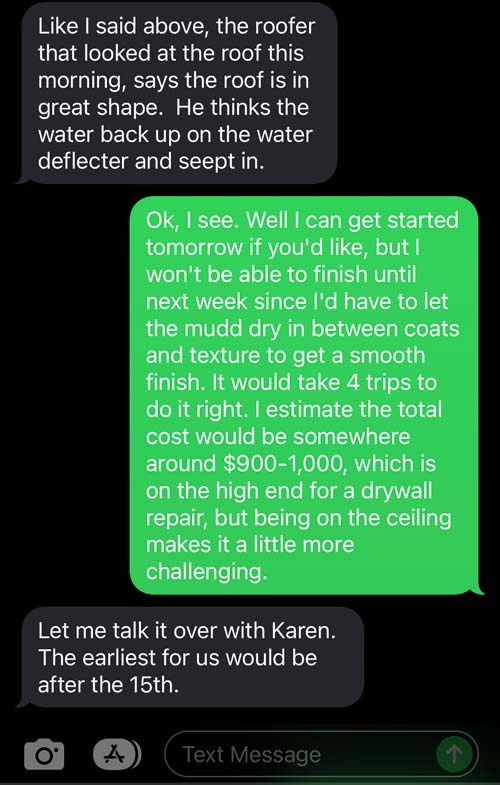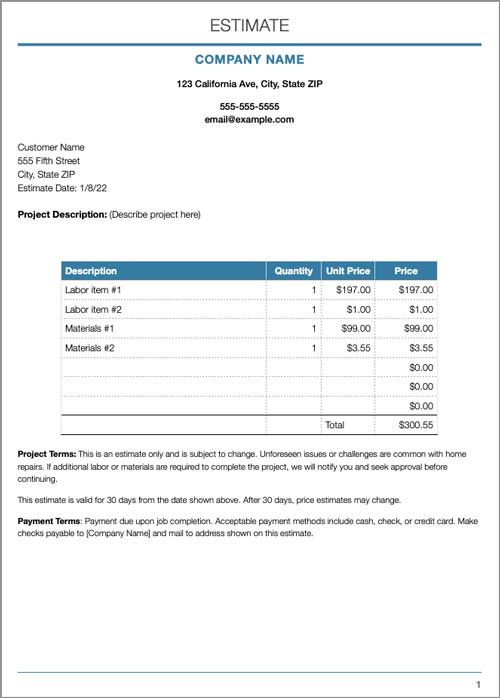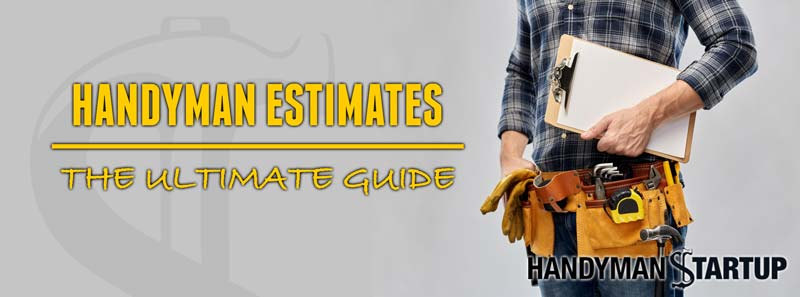After ten years of estimating handyman jobs, I’ve learned a few tricks. And in this article, I will share everything you need to know to estimate jobs quickly and accurately.
Whether you are looking for helpful estimating tips that will make you more money or just a free template you can use for your first estimate, I’ve got you covered.
Let’s get started.
Contents:
- Why estimating is so important
- How to estimate handyman jobs
- How to create and send a handyman estimate
- What to include in a handyman estimate
- Do you always need an estimate?
- Free handyman estimate template
- Five tips for more profitable estimates

Listen to the podcast version of this article, which includes extra content and tips. Listen right here or on your favorite podcast app!
HS039 – Estimating Handyman Jobs – Proven Tips for Boosting Income
Why estimating handyman jobs is so important.
The decision about how much to charge is where your profits are made or lost. If you underestimate a project, you lose money and waste time. Overestimating is preferable, but can lead to losing customers.
When you compare how much time you spend estimating a project to how much time you spend performing the labor, estimating takes up a relatively small amount of your time.
But, your decision in these short minutes (or even seconds) will impact your profitability for the entire job. A small mistake can cost you hundreds and sometimes thousands of dollars.
So it’s essential to give this process the respect and attention it deserves.
How to estimate handyman jobs (step-by-step)
You can use several methods to estimate a home improvement or repair.
One example is seen with painters or flooring installers, who often create estimates based on a project’s square footage or yardage.
Another example is seen with companies that charge flat rates for projects. A lawn care company may charge $35 per week for a mow-and-blow, or an electrician may charge $250 to wall mount a TV.
However, as a handyman, it rarely makes sense to copy these estimating strategies. Instead, it’s usually best to stick with good old T&M (time and materials), especially when first starting. T&M is when you simply estimate how long a project will take you, multiply that by your rates, and then add on the material costs.
Basing your estimates on time and materials is the best way to ensure you make a profit and avoid undercharging, especially when estimating your first few jobs.
If you ask pro handymen on online forums about how they charge, most experienced pros will say that charging by the hour is a terrible idea and you can make more money with a flat rate or quoting each job. But those pros have been in business for years and have estimated hundreds of projects. Most have forgotten what it’s like to be a beginner, so don’t listen to them. There’s nothing wrong with charging based on time. Most of the pros I consult with make more money using T&M to esimate.
Put simply, unless you specialize or have loads of experience, stick with T&M. As you gain more experience, you can utilize other methods.
Here’s how to estimate handyman jobs based on time and materials, step-by-step.
Step #1 – Assess the project
The first step is to thoroughly understand what the project entails. You’ll want to learn things like:
- What exactly needs to be done?
- What materials will you need?
- Is the project area easy to access?
- Is there anything that could go wrong or be more challenging once you get into the project?
- Is the customer going to be difficult to deal with?
Assessing the project may require a visit to the customer’s home. If you’ve never done a given project before, or if you’re just starting your handyman business, then seeing the project in person is essential to creating an accurate estimate.
However, once you gain experience, you may feel comfortable estimating based on pictures sent by the customer or asking the customer some questions. This is how I quote every job now, and I never give in-person free quotes because they eat into my profits.
Step #2 – Calculate the cost of labor
Once you have a clear picture of what needs to be done, the next step is to figure out how much you will charge for the labor portion of the project.
Understanding how much you must charge per hour (or per day) to generate a profit is essential before submitting your first estimate to a customer. Read this article to learn how to do that.
Assuming you know how much you need to charge for your time, here’s how to calculate the labor portion of your estimate:
- Break the project down into steps and write down each step.
- Visualize yourself completing each step and write down a time estimate for each step.
- Add up the time (include time for shopping, setup, and cleanup).
- Multiply the total time by your rates to get your labor.
- Then DOUBLE it.
Why double it?
Because of the little quirk in human psychology known as the Planning Fallacy, we all tend to underestimate how long a project will take (usually by about half), even if we have done a similar project. Things always seem more straightforward in your mind. But the reality of doing a project is always more complex.
So, I advise any new handyman to take your estimate of how long a project will take, then DOUBLE IT, and base your estimate on that amount of time.
Yes, it may be uncomfortable or extreme, but it’s better than underestimating a project and losing money.
It’s better to overestimate than to underestimate. If you overestimate, you risk losing the job to a lower bidder, which isn’t fun. But if you underestimate, you are guaranteed to waste time and make little to no money. Unless your main goal is to get some jobs under your belt, you’re better off spending your time on marketing than doing jobs that aren’t profitable.
Step #3 – Calculate the cost of materials
Here, you’ll determine how much you will charge for the labor portion of the estimate.
This process is similar to calculating the labor and goes like this:
- Visualize yourself completing each project step (don’t forget setup and cleanup).
- Make a list of materials you will need as you imagine doing the project.
- Take that list of materials and write down the cost of each item. You may have to do some shopping online to figure out the cost.
- Total up the materials and then apply a markup.
The amount you will charge for materials will be the total cost plus whatever markup you apply. To learn more about the appropriate markup for materials, consider investing in my pricing course for pros.
Step #4 – Add it up!
Now that you have the labor and materials, simply add these together to create your estimate.
It’s important to note that most of your profits as a pro handyman will come from your labor. As a self-employed handyman, your profits should be built into your rates, so there is no need to apply a markup to the labor portion of your estimate.
However, you may calculate your profits slightly differently if you run a company with employees. For example, you may calculate the total cost of materials and labor, then apply a markup of 25% to the entire job. But, as a self-employed handyman, it’s usually best to simply calculate your profits into your rates, as I demonstrate here.
How to create and send a handyman estimate
There are several ways to provide estimates to potential customers, and there is no correct answer for every situation.
Sometimes you may give a verbal estimate over the phone. Other times, you may send your quote via text. And in some cases, you may write up a formal estimate, email it to the customer, and have them sign it (several apps make this process seamless).
Which option you choose depends on who the estimate is sent to, your relationship with that person, and what the job entails.
Recently, a new customer called me to hang two TVs on the wall. I’ve hung hundreds of TVs, so I gave her a verbal quote on the phone. She agreed to the price and scheduled the job immediately.
When one of my repeat customers had a drywall repair, he texted me. I had him send me some pictures from there, and we continued our conversation via text. I even sent my estimate via text.
Here it is…

The customer accepted my quote a hired me.
Other times (usually when working for a new customer), I’ll use an app on my phone to quickly create a formal estimate and email it. I never require anyone to sign a contract or estimate because my average job size is so small.
The point is that you don’t have to overthink your estimate for handyman jobs. A verbal estimate usually suffices since most jobs are just a few hundred bucks. A more formal, signed estimate is probably necessary when tackling a bigger project like a kitchen remodel.
Of course, it’s nice to have the estimate in writing, but if you are dealing with someone who will stiff you, they will stiff you whether it’s in writing or not.
Three ways to create a written estimate:
- Use a smartphone app (BEST) – This is the easiest and fastest method. Writing an estimate this way takes seconds, and you can usually send the estimate right from the app. I recently wrote an in-depth article on handyman software where you can find my recommendation for which apps to use.
- Use Excel – This is the old-school way, but it still works. If you are just trying to send one or two estimates without downloading an app, this is a good way.
- Word processor – Microsoft Word or Apple Pages can also work. Any word processor can work. Again, overthinking this isn’t going to land you more jobs.
What to include in an estimate
What you include in your estimate is far more important than how you create or deliver it.
Whether you text your estimates or create fancy written estimates and hand-deliver them with a box of chocolates, the key components are always the same.
Essential components of a handyman estimate:
- Description of work – You want to be ultra clear on what the estimate covers and, often more importantly, what it does NOT cover. Sometimes, all you need is one line of text to describe the work, like “wall mount two TVs.” In other cases, you may need to explain the project in depth.
- The estimated price – This can be in one lump sum, or you can itemize everything.
- Important disclaimers – Some projects can start small and become much more extensive. For example, if you are going to replace some damaged siding, you never know what you will find behind that siding. The estimate is your chance to manage the customer’s expectations so they aren’t met with additional charges they didn’t see coming. If you think there could be an issue, let the customer know in the estimate.
Additional “nice-to-have” components of a handyman estimate
- Benefits of hiring you – If a potential customer is getting multiple estimates, finding a way to differentiate yourself is helpful. Otherwise, all the customer has to compare is the price. My favorite way to use the project description to imply some benefits. Let’s say I was building a new gate. I may say something like “Construct gate with diagonal support to prevent sagging” and “install reliable latching mechanism.” Even if other pros will build the gate the same way, the customer is assured that the gate I build won’t sag and will latch reliably. There are a million ways to do this, and it can be done in writing on the estimate or verbally when you speak with the customer.
- Your availability – I don’t include this on the estimate itself, but with my message when I deliver it. Since handyman jobs are usually small, customers don’t want to go back and forth a hundred times just to get it scheduled. They want clear, concise communication. That’s why I always include my next available times whenever I submit an estimate. This serves two purposes. It reduces back and forth and gives the customer a sense of urgency to get back to me before my schedule fills up.
Components of a written estimate
- Your company information (name, address, phone #, email)
- Customer information (name & address)
- Date estimate was created
- Project description
- Estimated cost (can be itemized or one lump sum)
- Important disclaimers and exclusions
- The expiration date of the estimate
- Payment terms
- Acceptable payment methods
Should you require a customer signature on your estimate?
You can have the customer sign and approve the estimate before you start if necessary. But as I mentioned, most handyman jobs are small (around $200-$1,000), so formal contracts are rarely worth the time and formality.
As long as you communicate clearly with the customer before, during, and after the project, you will run into very few problems with customers questioning your bill at the end.
And from my experience, 99% of customers will pay without hassle. I’ve only had a few customers not pay me the entire time I’ve been in business, and I doubt having a signed contract would have changed anything.
If you’re dealing with a customer you don’t trust, you may be better off turning down the job. You’ll probably avoid more than one headache by doing so.
Do customers always need an estimate?
No, in many cases, as you build trust with clients, they will no longer ask how much a project will cost. Instead, they would rather just skip the whole estimating process and have you get to work.
Estimates are most important when doing more extensive projects or dealing with new customers, commercial customers, or customers who are challenging to deal with.
Free handyman estimate template
As mentioned above, some great apps make creating and sending handyman estimates easy. These are the way to go if you are serious about growing your business.
However, if you just want a template to use now, click the link below and download a free handyman estimate template. (You may need to right-click to download).

Handyman Estimating Template (Microsoft Excel)
Handyman Estimating Template (Microsoft Word)
Handyman Estimating Template (macOS Pages)
Handyman Estimating Template (macOS Numbers)
Five handymen estimating tips for higher profits
Now that you know how to estimate a handyman job, here are some tips to help you boost your profits and conversions.
Tip #1 – Understand your numbers
The most critical step in creating estimates is understanding how much you need to charge for your time to make a profit and run a sustainable business. You don’t want to have just a general idea. You want to have an exact number.
When most handyman business owners finally dig into the math, they realize they need to charge more than they thought they needed. That’s because hidden expenses add up, and what you make as an employee is nowhere near what you need to charge as a business.
Tip #2 – It’s better to overbid than to underbid
When you underestimate how long a project will take, and the customer hires you, you are guaranteed to lose money, waste time, and experience frustration.
But, when you overestimate, you only increase your odds (sometimes only slightly) of losing the job to your competition. In many cases, when you overestimate, you’ll still get hired, which means you either make more money, spend a little more time doing an outstanding job, or cut the customer a discount when the project is done.
If you lose a job because you were too expensive, it’s far better than getting a job for being the lowest bidder and then ending up working your ass off just to avoid losing money.
Good marketing eliminates the pain of losing a job to overbidding, so invest your time there.
Tip #3 – Be firm with your price, but try to save the customer money
I like to view my pricing as if some authority determined it, and I can’t change it. I let the profitability gods (math) set my pricing and never transgress. I never negotiate on my pricing for handyman jobs.
But, I try to save customers money in any way I can. For example, one of my customers hired me to replace some roof tiles a few months ago. He was a smart and handy guy. He just doesn’t like getting on the roof. So, I told him he could save a couple of hundred bucks by shopping for the replacement tiles himself since this is easy but time-intensive. He was happy to do the shopping, and I was happy to avoid it.
However, I wouldn’t recommend the same to every customer. Some customers want to save time and don’t want to deal with shopping. I try to read the situation and only make these recommendations for price-sensitive customers.
This helps build trust and gives the customer perspective when interpreting my prices. I’m not out to price gouge people, but I’m not out to give my time away, either.
Tip #4 – When in doubt, double your estimate
If you’re quoting a project that you’ve never done before, or you just don’t have much experience quoting a particular type of project, you will have a natural tendency to underbid (which can cost you a lot). This is normal, and everyone does it.
So, once you’ve thoughtfully created an estimate of how long it will take you, double that time. Seriously, double it. At a very minimum, add an extra 50%.
This may seem extreme, but this tip alone can save you hundreds of dollars on your next job.
Tip #5 – Give options (pricing tiers)
In some cases, giving different pricing options for a project can be helpful.
For example, customers may call you because their gate isn’t latching. After looking at the gate, you may see they would benefit from a completely new one. In this instance, you could give them three different quotes:
- A quote for fixing their existing latch (cheapest option)
- A quote for replacing the existing latch with a better one (middle option)
- A quote for building an entirely new gate that doesn’t sag (most expensive option)
Providing the customer with options is helpful because it places them in a position of power. Even though there is a good argument that more options lead to lower satisfaction in life and fixing gates, people like to have options.
Conclusion
Estimating handyman jobs is an important skill to learn as a handyman because it has a tremendous impact on your profits.
There is a steep learning curve, and you are bound to underbid at least a few jobs, but by having a system to follow and learning the right perspective, you can significantly increase your income.
I’ve shared some powerful tips in this article. Still, if you are serious about growing a profitable handyman business, I highly recommend you invest in my course on handyman pricing – $100K Handyman Pricing. You’ll learn secrets, strategies, and mindsets you can’t find anywhere else that will boost your confidence and your profits.






Good Evening Dan,
I read over your email and enjoyed your suggestions. I have been doing handyman work on a more “professional” level for about 4+ years. While working a 8-5 job, I did jobs for family and friends.
I have asked clients to send pics for review. I will write up and print an estimate. Then text a pic of it to the client. I do add that additional materials may be needed due conditions unseen. Like an auto mechanic working on a engine. Cannot see in the engine until broken down. I do ask for down payment if job is costly. Or if I do not know or not recommended to me. Rental properties and the owner is not local could be a problem.
I tried to download the templates for my Mac. Message said, “‘Estimate+Template+pages.pages” cannot be opened. “The required index.xmi file is missing”. Not sure what I did wrong. I will try later.
I appreciate your emails and always look forward to reading them.
May you and your family have a safe and wonderful Merry Christmas and a Happy New Year.
Thank you,
Jerry O’Shesky
Hello Dan. I have found that the average homeowner looking to have some work done, doesn’t really have a clue on just how much is involved in even some of the smallest projects. So for years now on every project estimate, I have included in detail all the steps required for a proper completion of their project. You’d be surprised how many people say: “I had no idea how much was involved”. It makes it easier for a customer to approve a higher dollar estimate. It takes longer to write up that type of estimate, but the results make it worth it. And it’s a good mental prep prior to starting the job.
Awesome tip, Paul. I’ve done the same on many occasions and thanks for sharing this here.
-Dan
Hi Dan, excellent, whilst I have been a handyman since 2017 in Auckland NZ, I still learn from you. I have purchased some of your training. The thing I took away today, is if you are estimating a job you haven’t done before, work time out as you describe then DOUBLE it. Yes I have fallen short in the past and one thing that can also happen is that you start to rush the job as it is taking so long and you are aware you are now loosing money, so the clients isn’t getting the best job necessarily and worst of all you are prone to getting injured in your frustration state.
I know exactly what you’re talking about. Been there many times. Thanks for sharing this because I know others will find it valuable as well.
Thanx for the details of this topic of estimating the jobs. Very informative and I have learnt a lot from it. Thanx a million.
Glad you enjoyed it!
Awesome tips. Informative article. Thanks for sharing.
You’re welcome! Thanks for stopping by.
-Dan
nice job you are doing Dan..
I followed listened via the podcast, but I felt I was missing somethings.
Am currently looking for better ways to structure my current service (I do rooftop solar panels installations).
I just found your podcast 2months ago and it has been helpful, most especially this topic.
Sending love from 🇳🇬
You’re welcome. Happy to help!
I was reading the above comments without really paying attention to who wrote them, when I starting reading another one and thought “This guy does his estimates just like I do”. Then I looked at the author, and it was me! LMFAO!
That’s so funny! Thanks for reading….twice.
From unraveling the intricacies of pricing to decoding the elements that shape estimates, this resource is your compass in the world of home improvement. Whether you’re a seasoned homeowner or a novice DIY enthusiast, this guide equips you with the knowledge needed
This blog is your ultimate ally in navigating the world of handyman estimates! Gain valuable insights, from project scoping to pricing strategies, empowering you to plan home improvements with confidence. Whether you’re a homeowner or a handyman, this guide ensures you make informed decisions for successful projects.